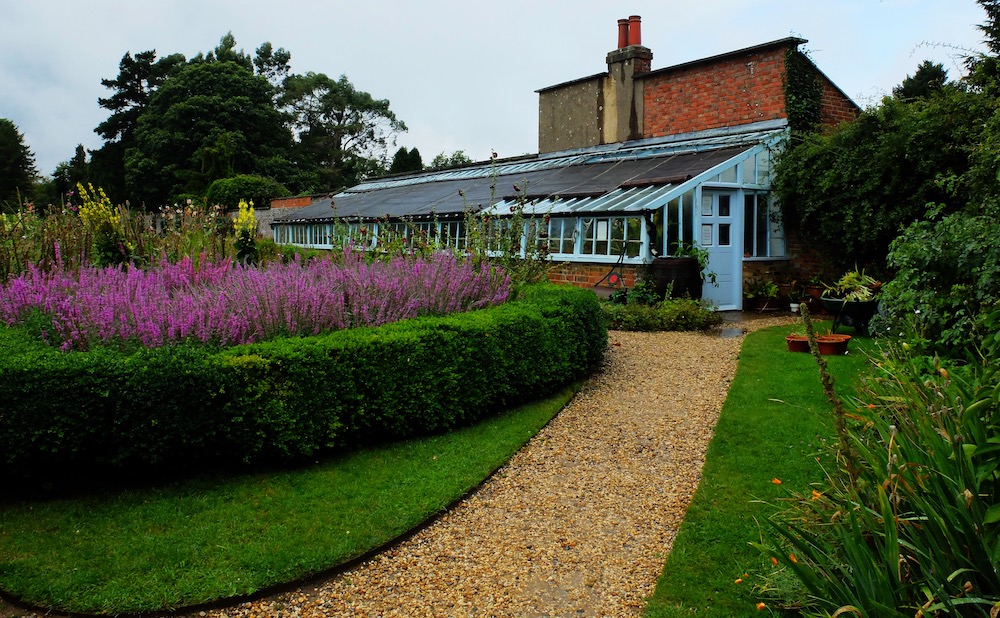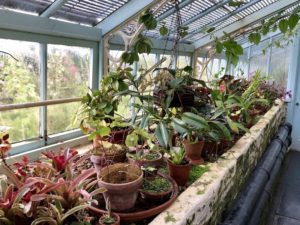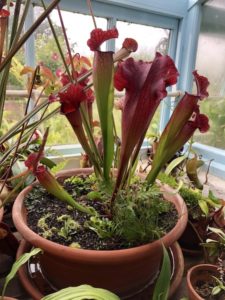“During the summer of 1860, I was surprised by finding how large a number of insects were caught by the leaves of the common sun-dew (Drosera rotundifolia) on a heath in Sussex. I had heard that insects were thus caught, but knew nothing further on the subject.”
So begins Charles Darwin’s book Insectivorous Plants, published in 1875, following fifteen years of work and study; a book that from its very first lines to its last testifies to the inexhaustible patience and curiosity of one of the world’s greatest naturalists. It is also a book, I am embarrassed to write, the existence of which I was wholly unaware until rather recently.
In 2019 I made a visit to the Darwin family home – Down House – in Kent. Now an English Heritage site, the house has been partially remade to accommodate a tea room and gift shop; however the garden, sand walk, and greenhouse remain largely as they were in his own lifetime. And it was as a result of my friend Paul and I strolling through the gardens and happening upon the greenhouse that my eyes were opened unto an entire facet of Darwin’s work of which I had until that time been ignorant.

Like many who read Darwin’s writings today, I had read On the Origin of Species and The Voyage of the Beagle, as well as portions of such other also reasonably well-known works such as The Descent of Man and, thanks to Katrina van Grouw’s superb book Unnatural Selection, his Variation of Animals and Plants Under Domestication. However many of his others, being somewhat less commonly referenced today and increasingly difficult to obtain, had either remained unknown to me or, if known, appeared to be addressing a subject I thought myself insufficiently knowledgable to even attempt reading (the Cirripedia works, for example).
 As Paul and I stepped through the greenhouse door into the glass-enclosed walkway, the array of carnivorous plants immediately caught my attention. At first I assumed they were simply placed there for display. However the more I contemplated them, the more I began to wonder – what did Darwin do in this remarkable greenhouse? What types of plants was he studying? What was he seeking to discover?
As Paul and I stepped through the greenhouse door into the glass-enclosed walkway, the array of carnivorous plants immediately caught my attention. At first I assumed they were simply placed there for display. However the more I contemplated them, the more I began to wonder – what did Darwin do in this remarkable greenhouse? What types of plants was he studying? What was he seeking to discover?
 It should have been obvious to me – motivated purely by his own insatiable inquisitiveness, he was seeking to discover more about anything he could. If something caught his attention and piqued his curiosity, he immediately set about acquiring a better understanding of it. Such was the case with his studies of insectivorous plants.
It should have been obvious to me – motivated purely by his own insatiable inquisitiveness, he was seeking to discover more about anything he could. If something caught his attention and piqued his curiosity, he immediately set about acquiring a better understanding of it. Such was the case with his studies of insectivorous plants.
Inspired by noticing the sticky secretions of a sun-dew, Darwin went on over the next fifteen years to observe and document the sensitivity of motile species to insects while being unaffected by wind or rain, how insectivorous plants thrived in nitrogen poor environments, and how their digestive processes functioned.
 It is in those fleeting moments when I find myself staring intently at a rock, plant, animal, or even such less substantial aspects of the natural world such as clouds, puzzling over why it is as it is, how it formed, what it is doing, or some similar question that I think myself a true naturalist. Unfortunately, given the vicissitudes of modern daily life, such moments are all to few and all to brief. I like to think Darwin knew them to be more frequent and long-lasting. His Insectivorous Plants certainly appears to recount a significant portion of a decade and a half spent in such an extended moment of focused investigation, and if I can’t quite manage such efforts on my own part, I can most certainly enjoy reading about his own, and take enjoyment from him having recorded them.
It is in those fleeting moments when I find myself staring intently at a rock, plant, animal, or even such less substantial aspects of the natural world such as clouds, puzzling over why it is as it is, how it formed, what it is doing, or some similar question that I think myself a true naturalist. Unfortunately, given the vicissitudes of modern daily life, such moments are all to few and all to brief. I like to think Darwin knew them to be more frequent and long-lasting. His Insectivorous Plants certainly appears to recount a significant portion of a decade and a half spent in such an extended moment of focused investigation, and if I can’t quite manage such efforts on my own part, I can most certainly enjoy reading about his own, and take enjoyment from him having recorded them.

February 12, 2020 @ 11:04
I grew up in the Big Thicket area of Texas. Pitcher Plant Trail was between my house and my high school (16 miles away). There are sun dews there too. It was one of those things I always took for granted as just being there until I was in college helping my mentor professor host chautauquas and people were coming from all around the world to see these things. It is what started me thinking about the exotic v familiar in nature which extended from the natural world to collections of the natural world in museums. I also never thought I would miss Pine Trees.